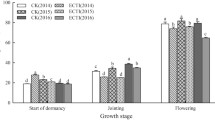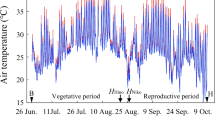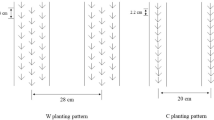Abstract
North China is one of the main regions of irrigated winter wheat production in China. Climate warming is apparent in this region, especially during the growing season of winter wheat. To understand how the yield of irrigated winter wheat in North China might be affected by climate warming and CO2 concentration enrichment in future, a set of manipulative field experiments was conducted in a site in the North China Plain under increased temperature and elevated CO2 concentration by using open top chambers and infrared radiator heaters. The results indicated that an average temperature increase of 1.7°C in the growing season with CO2 concentration of 560 μmol mol−1 did not reduce the yield of irrigated winter wheat. The thousandkernel weight of winter wheat did not change significantly despite improvement in the filling rate, because the increased temperature shortened the duration of grain filling. The number of effective panicles and the grain number per ear of winter wheat did not show significant changes. There was a large increase in the shoot biomass because of the increase in stem number and plant height. Consequently, under the prescribed scenario of asymmetric temperature increases and elevated CO2 concentration, the yield of irrigated winter wheat in North China is not likely to change significantly, but the harvest index of winter wheat is likely to be greatly reduced.
Similar content being viewed by others
References
Amthor, J. S., 2001: Effects of atmospheric CO2 concentration on wheat yield: Review of results from experiments using various approaches to control CO2 concentration. Field Crops Res., 73, 1–34.
Asseng, S., F. Ewert, C. Rosenzweig, et al., 2013: Uncertainty in simulating wheat yields under climate change. Nature Climate Change, 3, 827–832.
Bai Liping and Zhou Guangsheng, 2004: Responses and adaptations of wheat to elevated CO2 concentration and temperature rise. Chin. J. Eco-Agr., 12, 23–26. (in Chinese)
Batts, G. R., J. I. L. Morison, R. H. Ellis, et al., 1997: Effects of CO2 and temperature on growth and yield of crops of winter wheat over four seasons. Europ. J. Agron., 25, 67–76.
CCNARCC (Compilation Committee of National Assessment Report of Climate Change), 2007: China’s National Assessment Report on Climate Change. Science Press, Beijing, 710 pp.
Chen Qun, Yu Huan, Hou Wenjia, et al., 2014: Impacts of climate warming on growth development process and yield of winter wheat in Huang-Huai-Hai region of China. J. Trit. Crops., 34, 1363–1372. (in Chinese)
Cheng, W. G., H. Sakai, K. Yagi, et al., 2009: Interactions of elevated [CO2] and night temperature on rice growth and yield. Agr. Forest Meteor., 149, 51–58.
Cui Hao, Shi Zu-liang, Cai Jian, et al., 2011: Effects of atmospheric CO2 concentration enhancement and nitrogen application rate on wheat grain yield and quality. Chin. J. Appl. Ecol., 22, 979–984. (in Chinese)
Cynthia, R., and F. N. Tubiello, 1996: Effects of changes in minimum and maximum temperature on wheat yields in the central USA simulation study. Agr. Forest Meteor., 80, 215–230.
Easterling, D. R., B. Horton, P. D. Jones, et al., 1997: Maximum and minimum temperature trends for the globe. Science, 277, 364–367.
Fang Shibo, Tan Kaiyan, and Ren Sanxue, 2010: Winter wheat yields decline with spring higher night temperature by controlled experiments. Sci. Agric. Sin., 43, 3251–3258. (in Chinese)
Fang Shibo, Tan Kaiyan, Ren Sanxue, et al., 2012: Field experiments in North China show no decrease in winter wheat yields with night temperature increased by 2.0–2.5°C. Sci. China (Earth Sci.), 55, 1021–1027. (in Chinese)
Fang, S. B., D. Cammarano, G. S. Zhou, et al., 2015: Effects of increased day and night temperature with supplemental infrared heating on winter wheat growth in North China. Eur. J. Agron., 64, 67–77.
Grant, R. F., B. A. Kimball, M. M. Conley, et al., 2011: Controlled warming effects on wheat growth and yield: Field measurements and modeling. Agron. J., 103, 1742–1754.
Heinemann, A. B., A. H. N. de Maia, D. Dourado-Neto, et al., 2006: Soybean (Glycine max (L.) Merr.) growth and development response to CO2 enrichment under different temperature regimes. Eur. J. Agron., 24, 52–61.
IPCC (Intergovernmental Panel on Climate Change), 2001: Third Assessment Report: Climate Change 2001 (TAR). Available: http://www.ipcc.ch/publications-and-data/publications-and-data-reports.htm.
IPCC, 2007: Fourth Assessment Report: Climate Change, 2007 (AR4). Available: http://www.ipcc.ch/publications-and-data/publications-and-data-reports.htm.
Kim, S.-H., D. C. Gitz, C. S. Richard, et al., 2007: Temperature dependence of growth, development, and photosynthesis in maize under elevated CO2. Environ. Exp. Bot., 61, 224–236.
Kimball, B. A., 2005: Theory and performance of an infrared heater for ecosystem warming. Glob. Change Biol., 11, 2041–2056.
Kimball, B. A., P. J. Pinter Jr., R. L. Garcia, et al., 1995: Productivity and water use of wheat under free-air CO2 enrichment. Glob. Change Biol., 1, 429–442.
Ko, J., L. Ahuja, B. Kimball, et al., 2010: Simulation of free air CO2 enriched wheat growth and interactions with water, nitrogen, and temperature. Agr. Forest Meteor., 150, 1331–1346.
Krishnan, P., D. K. Swain, B. C. Bhaskar, et al., 2007: Impact of elevated CO2 and temperature on rice yield and methods of adaptation as evaluated by crop simulation studies. Agr. Ecosyst. Environ., 122, 233–242.
Leakey, A. D. B., E. A. Ainsworth, C. J. Bernacchi, et al., 2009: Elevated CO2 effects on plant carbon, nitrogen, and water relations: Six important lessons from FACE. J. Exp. Bot., 60, 2859–2876.
Lee, J.-S., 2011: Combined effect of elevated CO2 and temperature on the growth and phenology of two annual C3 and C4 weedy species. Agr. Ecosyst. Environ., 140, 484–491.
Lee, J., S. De Gryze, and J. Six, 2011: Effect of climate change on field crop production in California’s Central valley. Climatic Change, 109, 335–353.
Li Sanai, T. Wheeler, A. Challinor, et al., 2010: Simulating the impacts of global warming on wheat in China using a large area crop model. Acta Meteor. Sinica, 24, 123–135.
Liu, S. X., X. G. Mo, Z. H. Lin, et al., 2010: Crop yield responses to climate change in the Huang-Huai-Hai Plain of China. Agr. Water Manag., 97, 1195–1209.
Long, S. P., E. A. Ainsworth, A. D. B. Leakey, et al., 2006: Food for thought: Lower-than-expected crop yield stimulation with rising CO2 concentrations. Science, 312, 1918–1921.
Luo, Q. Y., W. Bellotti, M. Williams, et al., 2005: Potential impact of climate change on wheat yield in South Australia. Agr. Forest Meteor., 132, 273–285.
Lü Zunfu, Liu Xiaojun, Cao Weixing, et al., 2013: Climate change impacts on regional winter wheat production in main wheat production regions of China. Agr. Forest Meteor., 171–172, 234–248.
Matsunami, T., M. Otera, S. Amemiya, et al., 2009: Effect of CO2 concentration, temperature and N fertilization on biomass production of soybean genotypes differing in N fixation capacity. Plant Prod. Sci., 12, 156–167.
Morison, J. I. L., and D. W. Lawlor, 1999: Interactions between increasing CO2 concentration and temperature on plant growth. Plant Cell. Environ., 22, 659–682.
de Oliveira, E. D., H. Bramley, K. H. M. Siddique, et al., 2012: Can elevated CO2 combined with high temperature ameliorate the effect of terminal drought in wheat? Func. Plant Biol., 40, 160–171.
Özdoğan, M., 2011: Modeling the impacts of climate change on wheat yields in northwestern Turkey. Agr. Ecosyst. Environ., 141, 1–12.
Ren Guoyu, Chu Ziying, Zhou Yaqing, et al., 2005: Recent progresses in studies of regional temperature changes in China. Climate Environ. Res., 10, 701–716. (in Chinese)
Roy, K. S., P. Bhattacharyya, S. Neogi, et al., 2012: Combined effect of elevated CO2 and temperature on dry matter production, net assimilation rate, C and N allocations in tropical rice (Oryza sativa L.). Field Crops Res., 139, 71–79.
Song Yanling and Zhao Yanxia, 2012: Effects of drought on winter wheat yield in North China during 2012–2100. Acta Meteor. Sinica, 26, 516–528.
Song, Y.-L., D.-L. Chen, Y.-J. Liu, et al., 2012: The Influence of climate change on winter wheat during 2012–2100 under A2 and A1B scenarios in China. Adv. Climate Change Res., 3, 138–146.
State Meteorological Administration, 1993: Agricultural Meteorological Observation Specification. China Meteorological Press, Beijing, 212 pp. (in Chinese)
Streck, N. A., 2005: Climate change and agroecosystems: The effect of elevated atmospheric CO2 and temperature on crop growth, development, and yield. Ciência Rural, 35, 730–740.
Supit, I., C. A. van Diepen, A. J. W. de Wit, et al., 2012: Assessing climate change effects on European crop yields using the Crop Growth Monitoring System and a weather generator. Agr. Forest Meteor., 164, 96–111.
Tan Kaiyan, Fang Shibo, and Ren Sanxue, 2012: Experimental study on effects of temperature increase on wheat production in North China. Acta Meteor. Sinica, 70, 902–908. (in Chinese)
Tao Fulu, Zhang Shuai, and Zhang Zhao, 2012: Spatiotemporal changes of wheat phenology in China under the effects of temperature, day length, and cultivar thermal characteristics. Eur. J. Agron., 43, 201–212.
Tao Fulu and Zhang Zhao, 2013: Climate change, wheat productivity and water use in the North China Plain: A new super-ensemble-based probabilistic projection. Agr. Forest Meteor., 170, 146–165.
Tao Fulu, Zhang Zhao, Xiao Dengpan, et al., 2014: Responses of wheat growth and yield to climate change in different climate zones of China, 1981–2009. Agr. Forest Meteor., 189–190, 91–104.
Tian Yunlu, Chen Jin, Chen Changqing, et al., 2012: Warming impacts on winter wheat phenophase and grain yield under field conditions in Yangtze Delta Plain, China. Field Crops Res., 134, 193–199.
Wang Chunyi, Pan Yaru, Bai Yueming, et al., 1997: The Experiment study of effects doubled CO2 concentration on several main crops in China. Acta Meteor. Sinica, 55, 86–94. (in Chinese)
Wang Futang, 2001: Some advances in climate warming impact research in China since 1990. Acta Meteor. Sinica, 15, 498–508.
Xiao Dengpan and Tao Fulu, 2014: Contributions of cultivars, management and climate change to winter wheat yield in the North China Plain in the past three decades. Eur. J. Agron., 52, 112–122.
Xiao Guoju, Zhang Qiang, Li Yu, et al., 2010: Impact of temperature increase on the yield of winter wheat at low and high altitudes in semiarid northwestern China. Agr. Water Manag., 97, 1360–1364.
Xiong Wei, Ju Hui, Xu Yinlong, et al., 2006: Regional simulation of wheat yield in China under the climatic change condition. Chin. J. Eco-Agr., 14, 164–167. (in Chinese)
Xiong Wei, Ian P. Holman, You Liangzhi, et al., 2014: Impacts of observed growing-season warming trends since 1980 on crop yields in China. Reg. Environ. Change, 14, 7–16.
Xu Yinlong, Huang Xiaoying, Zhang Yong, et al., 2005: Statistical analyses of climate change scenarios over China in the 21th century. Adv. Climate Change Res., 1, 80–83. (in Chinese)
Yang Lianxin, Li Shifeng, Wang Yulong, et al., 2007: Effects of the increase of open atmospheric CO2 concentration on wheat yield. Chin. J. Appl. Ecol., 18, 75–80. (in Chinese)
Yang Peng, Wu Wenbin, Li Zhengguo, et al., 2014: Simulated impact of elevated CO2, temperature, and precipitation on the winter wheat yield in the North China Plain. Reg. Environ. Change, 14, 61–74.
Yoon, S. T., G. Hoogenboom, L. Flitcroft, et al., 2009: Growth and development of cotton (Gossypium hirsutum L.) in response to CO2 enrichment under two different temperature regimes. Environ. Exp. Bot., 67, 178–187.
Zheng Youfei, Hu Huifang, Wu Rongjun, et al., 2013: Combined effects of elevated O3 and reduced solar irradiance on growth and yield of field-grown winter wheat. Acta Ecol. Sinica, 33, 532–541. (in Chinese)
Zhu Xinkai, Feng Zhaozhong, Sun Taofang, et al., 2011: Effects of elevated ozone concentration on yield of four Chinese cultivars of winter wheat under fully open-air field conditions. Glob. Change Biol., 17, 2697–2706.
Author information
Authors and Affiliations
Corresponding author
Additional information
Supported by the National Natural Science Foundation of China (41075085 and 41375118) and National (Key) Basic Research and Development (973) Program of China (2010CB951303).
Rights and permissions
About this article
Cite this article
Tan, K., Fang, S., Zhou, G. et al. Responses of irrigated winter wheat yield in North China to increased temperature and elevated CO2 concentration. J Meteorol Res 29, 691–702 (2015). https://doi.org/10.1007/s13351-014-4124-1
Received:
Accepted:
Published:
Issue Date:
DOI: https://doi.org/10.1007/s13351-014-4124-1




